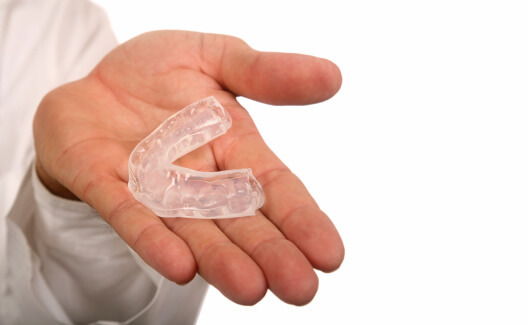
Guide to Dental Mouth Guards
Mouth guards are special guards that protect your teeth if you play sports or suffer from TMJ disorder. Since people who have TMD clench or grind their teeth at night, a mouth guard is recommended by dentists to be worn overnight to help cushion the teeth from severe pressure. A mouth guard can help save your teeth from breaking, as well as safeguard your teeth, tongue, lips, face and jaw from injury.
There are three types of mouth guards: custom fitted, mouth-formed, and stock guards. Each of these covers your upper teeth to keep the upper and lower jaw separate so the pressure of grinding your teeth in your sleep doesn’t cause serious damage.
Stock mouth guards are the most affordable of dental mouth guards and can be found in drug stores and sporting goods stores. The negatives of stock mouth guards are that they aren’t made to fit your teeth, so they aren’t the most comfortable and therefore don’t provide as much protection as one might like. Add to that that they can be bulky because they’re made of polyvinyl or rubber, they can fit too large and cause you to gag or make it hard to breathe because you have to hold your jaw closed to keep them in place. There are bonuses to having a stock mouth guard, though. Since they’re purchased off the shelf, they’re inexpensive to replace if you misplace them.
The most expensive, but the far superior mouth guard, is a custom-fitted one. Not only is it comfortable, but also it is made especially for you, so there’s no bulkiness. Custom-fitted mouth guards are made by taking an impression of your teeth with a special type of dental putty called alginate material. The impression is then sent to a lab, where a custom-made guard is created. Pressure laminated machines produce a better fitting product than a vacuum form machine, and it can make guards with many layers instead of just one.
Mouth-formed guards, also called boil-and-bite guards, are made of acrylic gel, rubber, or thermoplastic. The first type is made from a shell lined with acrylic gel to make a mold of your teeth to keep its shape. The second type is a thermoplastic shell boiled in water and formed to your teeth with your tongue, lips, biting pressure, and your fingers. One advantage of boil-and-bite guards is that they can be refitted if the initial shape was wrong. They also fit better than stock mouth guards, but they don’t provide the protection or exact fit necessary for your bite.
Maintaining your mouth guard is the key to making it effective. A clean mouth guard can prevent infection and stop disease from spreading, so it’s important to properly maintain it. First, make sure not to chew on your mouth guard because it can misshape it. Second, store it in a clean, dry place. Third, wash it each time after you wear it, but not in hot water. Finally, never share your mouth guard or handle a friend’s mouth guard.
To keep your mouth guard clean, wash it occasionally with warm soapy water and make sure you brush your teeth or at least rinse before putting in the guard. Keep it in a sturdy, vented container so it will stay clean and never leave it in hot water or wear it if it has a tear or looks worn down.